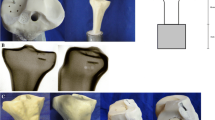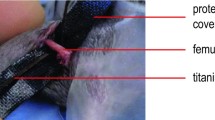Abstract
Introduction
The objectives of this study were to (1) establish a reproducible atrophic non-union model in rats by creation of a segmental femoral bone defect that allows, (2) in-depth characterization of impaired healing, and (3) contrast its healing patterns to the normal course. Hypothesis was that a 5-mm bone defect in male rats would deviate from uneventful healing patterns and result in an atrophic non-union.
Materials and methods
A femoral osteotomy was performed in two groups of 12-week-old male rats (1 vs. 5 mm gap) stabilized with an external fixator. Bone healing in these models was evaluated by radiology, biomechanics, and histology at 6 or 8 weeks. The evaluation of the 5-mm group revealed in some cases a delayed rather than a non-union, and therefore, a group of female counterparts was included.
Results
The creation of a 5-mm defect in female rats resulted in a reproducible atrophic non-union characterized by sealing of the medullary canal, lack of cartilage formation, and negligible mechanical properties of the callus. In both gap size models, the male subjects showed advanced healing compared to females.
Discussion and conclusion
This study showed that even under uneventful healing conditions in terms of age and bone defect size, there is a sex-specific advanced healing in male compared to female subjects. Contrary to our initial hypothesis, only the creation of a 5-mm segmental femoral defect in female rats led to a reproducible atrophic non-union. It has been shown that an atrophic non-union exhibits different healing patterns compared to uneventful healing. A total lack of endochondral bone formation, soft tissue prolapse into the defect, and bony closure of the medullary cavity have been shown to occur in the non-union model.




Similar content being viewed by others
References
Rodriguez-Merchan EC, Forriol F (2004) Nonunion: general principles and experimental data. Clin Orthop Relat Res 419:4–12
Tseng SS, Lee MA, Reddi AH (2008) Nonunions and the potential of stem cells in fracture-healing. J Bone Joint Surg Am 90(Suppl 1):92–98
Damien CJ, Parsons JR (1991) Bone graft and bone graft substitutes: a review of current technology and applications. J Appl Biomater 2:187–208
Hannouche D, Petite H, Sedel L (2001) Current trends in the enhancement of fracture healing. J Bone Joint Surg Br 83:157–164
DeCoster TA, Gehlert RJ, Mikola EA, Pirela-Cruz MA (2004) Management of posttraumatic segmental bone defects. J Am Acad Orthop Surg 12:28–38
Oest ME, Dupont KM, Kong HJ, Mooney DJ, Guldberg RE (2007) Quantitative assessment of scaffold and growth factor-mediated repair of critically sized bone defects. J Orthop Res 25:941–950
Gardner TN, Stoll T, Marks L, Mishra S, Knothe Tate M (2000) The influence of mechanical stimulus on the pattern of tissue differentiation in a long bone fracture—an FEM study. J Biomech 33:415–425
Schaden W, Fischer A, Sailler A (2001) Extracorporeal shock wave therapy of nonunion or delayed osseous union. Clin Orthop Relat Res 387:90–94
Claes L, Blakytny R, Gockelmann M, Schoen M, Ignatius A, Willie B (2009) Early dynamization by reduced fixation stiffness does not improve fracture healing in a rat femoral osteotomy model. J Orthop Res 27:22–27
Greiner SH, Wildemann B, Back DA, Alidoust M, Schwabe P, Haas NP, Schmidmaier G (2008) Local application of zoledronic acid incorporated in a poly(d,l-lactide)-coated implant accelerates fracture healing in rats. Acta Orthop 79:717–725
Nakajima F, Nakajima A, Ogasawara A, Moriya H, Yamazaki M (2007) Effects of a single percutaneous injection of basic fibroblast growth factor on the healing of a closed femoral shaft fracture in the rat. Calcif Tissue Int 81:132–138
Parker MJ, Raghavan R, Gurusamy K (2007) Incidence of fracture-healing complications after femoral neck fractures. Clin Orthop Relat Res 458:175–179
Strube P, Mehta M, Baerenwaldt A, Trippens J, Wilson CJ, Ode A, Perka C, Duda GN, Kasper G (2009) Sex-specific compromised bone healing in female rats might be associated with a decrease in mesenchymal stem cell quantity. Bone 45:1065–1072
Strube P, Mehta M, Putzier M, Matziolis G, Perka C, Duda GN (2008) A new device to control mechanical environment in bone defect healing in rats. J Biomech 41:2696–2702
Kaspar K, Schell H, Toben D, Matziolis G, Bail HJ (2007) An easily reproducible and biomechanically standardized model to investigate bone healing in rats, using external fixation. Biomed Tech 52:383–390
Schmidmaier G, Wildemann B, Melis B, Krummrey G, Einhorn TA, Haas N, Raschke M (2004) Development and characterization of a standard closed tibial fracture model in the rat. Eur J Trauma 30:35–42
Runkel M, Rommens PM (2000) pseudoarthrosis. Unfallchirurg 103:51–63
Strube P, Sentuerk U, Riha T, Kaspar K, Mueller M, Kasper G, Matziolis G, Duda GN, Perka C (2008) Influence of age and mechanical stability on bone defect healing: age reverses mechanical effects. Bone 42:758–764
Movat HZ (1955) Demonstration of all connective tissue elements in a single section: pentachrome stains. AMA Arch Pathol 60:289–295
Junqueira LC, Bignolas G, Brentani RR (1979) Picrosirius staining plus polarization microscopy, a specific method for collagen detection in tissue sections. Histochem J 11:447–455
Frolke JP, Patka P (2007) Definition and classification of fracture non-unions. Injury 38(Suppl 2):S19–S22
Marsh D (1998) Concepts of fracture union, delayed union, and nonunion. Clin Orthop Relat Res 355(Suppl):S22–S30
Megas P (2005) Classification of non-union. Injury 36(Suppl 4):S30–S37
Garcia P, Holstein JH, Maier S, Schaumloffel H, Al-Marrawi F, Hannig M, Pohlemann T, Menger MD (2008) Development of a reliable non-union model in mice. J Surg Res 147:84–91
Acknowledgments
This study was supported by a grant of the German Research Foundation (DFG SFB 760) and partially by the Berlin-Brandenburg Center for Regenerative Therapies (BCRT). The authors would like to thank Mario Thiele, Camilla Bergmann, Nicole Lautenschläger, and Dag Wulsten for excellent technical assistance.
Conflict of interest
The authors declare that they have no conflict of interest.
Author information
Authors and Affiliations
Corresponding author
Rights and permissions
About this article
Cite this article
Mehta, M., Schell, H., Schwarz, C. et al. A 5-mm femoral defect in female but not in male rats leads to a reproducible atrophic non-union. Arch Orthop Trauma Surg 131, 121–129 (2011). https://doi.org/10.1007/s00402-010-1155-7
Received:
Published:
Issue Date:
DOI: https://doi.org/10.1007/s00402-010-1155-7




